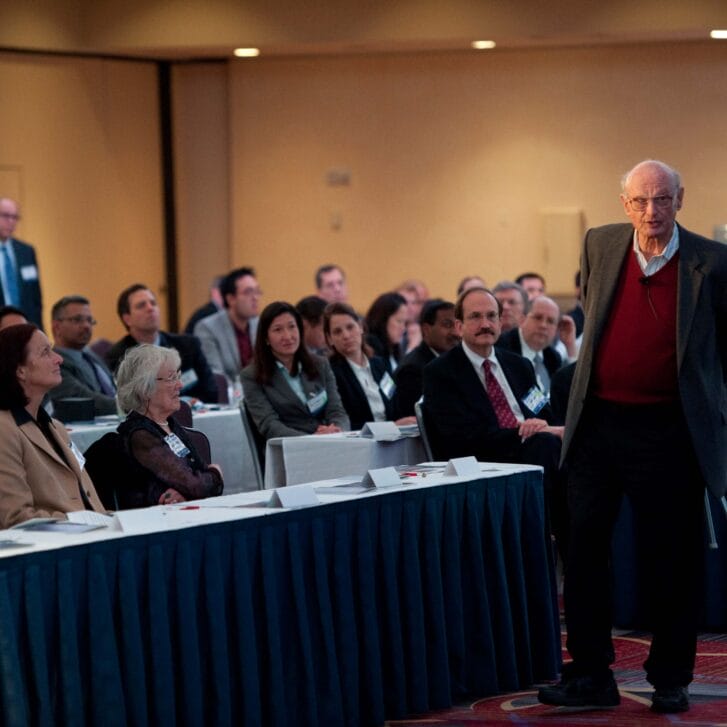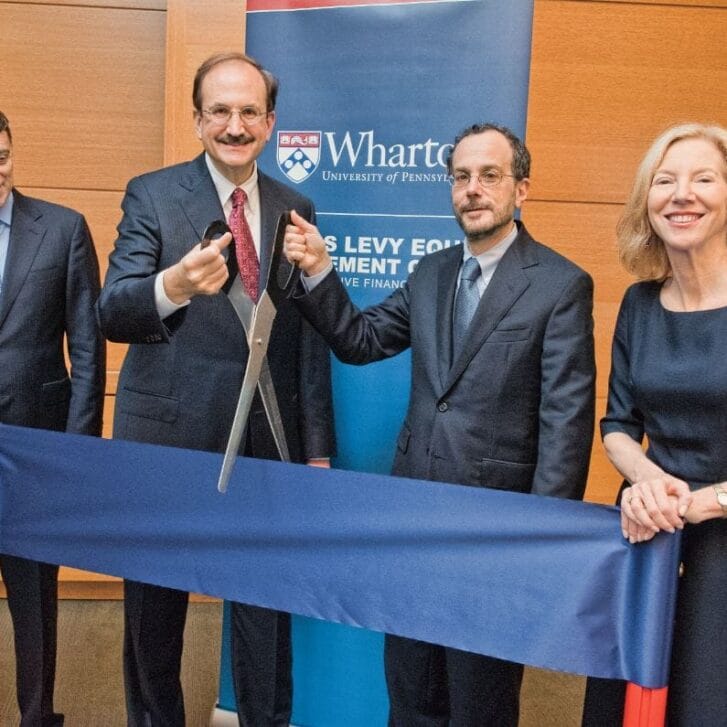The moment the alert popped up on her e-mail, Georgette Chapman Poindexter dropped interest in everything else.
She was in her office talking on the phone to an attorney who was peppering her with questions about a lawsuit in which she was serving as an expert witness.
For the upcoming court case, this was a vital conversation.
But it was also doomed.
It was June 23, 2005, around 10 a.m., and judging from the flood of e-mail alerts that were lighting up her computer screen, it could only mean one thing: The Supreme Court had rendered a verdict in Kelo v. New London.
The city of New London, CT, had wanted to take residential homes in order for private developers to build a hotel, offices, parking space and retail shops to complement a nearby Pfizer facility. Seven holdouts, led by Susette Kelo, had sued.
The decision would shed light on the reach of eminent domain and the definition of public use, questions Chapman Poindexter has spent her career ruminating.
“I said, ‘I’m sorry, I’m not paying any attention to you because they’ve just decided Kelo. I can’t talk to you right now. I have to go read this opinion,’” Chapman Poindexter recalls telling the bewildered litigator on the other end of the phone.
“My assistant called me, screaming, ‘I’m getting the opinion!’ It was something like the World Series,” she says.
When Public and Private Interests Collide
The excitement quickly spread. Within hours, the high court’s decision galvanized those in the industry. It was a contentious 5-4 split that gave local governments a new weapon to wield in their pursuit of economic development: broad range to condemn private homes and small businesses to enhance the tax base. The outcry was immediate and intense, across the spectrum of the political aisle. Some assailed the decision as an evisceration of the Fifth Amendment, which establishes that private property shall not be taken for public use without just compensation.
To Chapman Poindexter, who has spent years wrestling with the complexities of land use, the decision—despite the sting of the reproachful argument made by departing Justice Sandra Day O’Connor—was as it should be: an agonizing balance between individual property rights and the collective interest.
With this ruling, O’Connor wrote in her dissent, “The specter of condemnation hangs over all property. Nothing is to prevent the State from replacing any Motel 6 with a Ritz- Carlton, any home with a shopping mall, or any farm with a factory.”
Counters Chapman Poindexter: “Framed like that, you’ve just got to say ‘no.’ But maybe we shouldn’t be so cynical.”
“If we look at New London, it’s a kind of down-on-its-luck, struggling-to-survive city. You say to an electrician, ‘We’re going to have this great new employment opportunity for you, but this lady won’t give up her house.’ Well, what right do you have, Mrs. Kelo, from keeping this man from being able to feed his children?”
The sanctity of the individual, Chapman Poindexter says, cannot exist in isolation from the needs of the community.
Her perspective stems from years of looking at the colliding shades of public and private use. Beyond concerning herself with “physical” takings, such as the houses in New London, Chapman Poindexter has also focused on the more abstract questions raised by “regulatory” takings. The Federal Communication Commission, for example, requires landlords to open their doors freely to cable companies looking to install wiring and other infrastructure through the walls of a building. Landlords cannot charge for the privilege, nor can they turn down a request. The regulatory requirement constitutes an infringement on landlords’ property rights, Chapman Poindexter has argued in previous research.
She also studies the impact of the flow of property tax revenues in its myriad forms, from local governments granting tax credits to lure behemoth corporations into their towns, to sprawling suburban and exurbanites fleeing inner cities and gutting them of their core tax bases.
The subtexts may be different, but in each of those areas of research, the exploration remains fundamentally the same. Hers is a land-locked journey into the boundary between the public interest and private rights. She examines the terrain critically, recognizing the borders as both barrier and threshold.
“I’ve always been interested in human geography. Not physical geography. Human geography. Why do people live in certain places? Why do populations shift? Why does government have the right to regulate how we use land, and how much say should it have? It’s this collective/individual dichotomy that I like to draw on,” Chapman Poindexter says.
“Where does the individual end and the community begin?” she asks, posing the question at the heart of all her land-use research.
Where Main Street Meets Wall Street
The Question demands multiple perspectives; the answers lead her into another world. As the chairperson of the Real Estate Department at Wharton, Chapman Poindexter is not only steeped in real estate law, but real estate finance as well.
Chapman Poindexter’s financial lens has allowed her to resolve thorny issues that otherwise riddle land-use planners, particularly involving development moratoriums that have become increasingly popular in suburbs. An upcoming paper titled “Land Hungry” tackles the paradox of suburbanites fleeing the city to build spacious single houses on grassy lots, only to become suddenly troubled by sprawl and demanding that land adjacent to theirs remain undeveloped under the guise of preservation of open space.
From a legal perspective, the conservation is a “taking” of development rights. But the benefits are not equally distributed; those who live next to open space derive the most value from it. By characterizing development moratoriums as hybrids between public and private goods, Chapman Poindexter turns the “takings” issue on its head—framing it instead in the context of “giving” communal private property to a select group of private owners.
Placed in that perspective, Chapman Poindexter’s financial mastery comes into play. Any “giving” of open space to existing landowners should be paid for, she argues, in the form of a special tax assessed on those very landowners. The idea, in a sense, is the inverse version of the Fifth Amendment’s call for just compensation.
By borrowing the language of structured finance to examine questions of land-use, Chapman Poindexter takes each into a realm few researchers are willing to venture.
“Land has almost a religious attachment for many Americans,” she acknowledges in her work. Rather than ignoring the ineffable, Chapman Poindexter takes the internal perspective into account, understanding well that scientific knowledge ultimately depends on the nature of conscious experience. The interdependence of land and people, of law, economics and psychology, is a hallmark of her research.
Even her strictly financial work is informed by hues of gray. Chapman Poindexter’s most recent paper coins a new term—dequity—for the shade of financing between straight debt and equity called mezzanine that has become increasingly popular in real estate development.
Mezzanine loans are loans to equity holders of a mortgage borrower, secured by a pledge of the equity interests in the mortgage borrower. Not quite debt and not quite equity, but a little bit of both, they are comparable to convertible debt in the corporate world, albeit with a strike price of zero.
How this financing tier will fare in the event of default or bankruptcy is an unknown scenario that worries Chapman Poindexter, particularly given the approximately $135 billion of such mezzanine loans that are floating in the market.
“While the rights of the holder of a true second mortgage are well traveled and the rights of the holder of equity are well known, the rights of those who fall somewhere between debt and equity, the dequity holders, are subject to a certain amount of conjecture,” she writes.
To those who would dismiss such esoteric concerns, Chapman Poindexter retorts: “Aren’t you interested in what you’re buying? Don’t you care that it’s priced accurately?”
“You used to go to your local bank and get a loan,” she continues. “Now Goldman Sachs is floating your securitization. It’s a whole new world. There’s a ton of new product. People don’t understand how it works. It’s never been tested.”
With anxiety about “frothy” housing markets on the rise, concerns about untested markets can hardly be ignored.
Part of the problem, Chapman Poindexter says, is that the drive for security has led inadvertently to larger appetite for risk. Real estate’s journey over the past two decades from Main Street to Wall Street instilled underwriting discipline in the market, which in turn has created relative stability. New generations of investors, however, have forgotten—or never known —what it’s like to be burned.
“We’ve been 11 years of going gangbusters. Maybe we’ve forgotten that real estate can lose value,” she says.
What she sees now is a surge in speculation.
“Whenever someone says to me, ‘Should I get into the market?’ I say, ‘Are you going to live there?’ These are the same people who were asking ten years ago if they should invest in technology stock. What worries me is that people are buying houses as an investment. That’s risky,” she says.
“I have always been of the opinion that you buy a house to live in it. Otherwise you’re no longer in a residential market. You’re in a speculative market. And I don’t have the stomach for a speculative market of any sort,” she continues.
Sticks and Stones and Real Property
Then again, the groundswell of interest in real estate markets has spilled over into the classroom. Her MBA students are now as likely to become developers as they once were to structure real estate deals for investment banks. The change in her students excites her.
“I love the idea that they’re actually going to go out and create something, actually build stuff, not just trade paper,” she says. Her enthusiasm stems not only from a love of the built environment, but also from a hope that today’s students—and tomorrow’s developers—will create the built environment in resonance with the natural one.
“We have to care about our environmental legacy to our kids,” she says. “I’m talking about building smarter, greener buildings that rely less on fossil fuels and have south-facing lobbies. Buildings that are designed to be more environmentally friendly, I think that’s fantastic.”
But she doesn’t kid herself. As she knows well from her own research, a vision can become reality only when it emerges from within a community. Tax breaks and zoning laws can nudge and encourage, but neighborhood ideals cannot be externally imposed.
“Each community decides for itself what it wants to be, which brings me back to why I do both real estate finance and land use. If you’re concerned about capital, you better remember that you are building some place. I’m not trading swaps here. I’m putting sticks and concrete into the ground, and that ground belongs to somebody. You can’t forget that. That’s why I like going back and forth between the two,” she says.
True to form for someone with a bifurcated research agenda in which each branch informs the other, Chapman Poindexter’s grounding in such tangible things as land and buildings and neighborhoods stems from the existential—a realization that our very identities are linked to place. Where we choose to live speaks volumes about who we are.
“Newsflash: People like to live amongst those who are like themselves. We can say that’s wrong, we can say you should live in one big melting pot, but when we have the tendency to substitute place for identity, you can’t live in a big melting pot. When people ask where you’re from, depending on their perspective of that place, they will hold you to an identity,” she says.
The Philadelphia suburbs of Norristown and Gladwyne, for example, connote drastically different socio-economic backgrounds although both are in the same county.
“If you try to erase those boundaries, and you try to get people to say they’re from the greater Philadelphia area instead, well, that’s never going to happen,” she says.
Yet while Chapman Poindexter recognizes the impossibility of dictating geographical identity, she fervently believes the economic impact of our geographic decisions must be addressed.
“If you decide you don’t want to live in the city of Philadelphia, or in an economically diverse area, OK. But there has to be some level of economic redistribution that compensates for your decision if we’re going to allow you to cordon yourself off in an enclave.” Some kind of regionally imposed tax, she says, is necessary to cover the true cost of sprawl and to compensate those in higher density areas that are usually left to pay the price.
It’s the dichotomy between the individual and the community in yet another guise. Reified political boundaries, in other words, are no excuse for restricted financial flows across those boundaries and the economic disparity that can often result.
To that end, Wharton couldn’t be a more perfect home for Chapman Poindexter’s multi-faceted mind. A Harvard Law School graduate who spent part of her summer this year studying music theory in the Berkshires, Chapman Poindexter had seven years of private practice under her belt when she got the calling from Wharton in 1992.
At first, it was a difficult transition.
“I never thought I would be teaching,” she says.
But 13 years later, she can imagine no other place to work. “I love Penn. It’s a marvelous place. It gives me everything from a career perspective that I could want,” she says. “It has an absolutely stellar law school and an absolutely stellar business school that are a seven minute walk away from one another, and I get to teach at both.”
Ritu Kalra, W’96, a first-time contributor to this Magazine, is a reporter with the Hartford Courant. She worked as an investment banker and bond trader after graduating from Wharton and before attending journalism school.

























